The content of the article
Scottish fold cats are one of the most popular breeds in the world. Their individual peculiarity and the main difference of the breed are small ears that are tilted down. Breeders are so fond of breeders that it’s hard to imagine their life without them.
Description
Probably no one has a question, which country is the birthplace of Scottish fold cats. In addition to hanging ears, the breed also has some other features. According to approved standards, a Scottish cat must have the following characteristics:
- Body. Medium in size, closer to large. Average fatness, muscularity, with rounded lines. With a wide chest.
- Head. Round. The chin is well developed. Vibrissa pads are well defined.
- Eyes. Large and round. With a wide location.
- Nose. Not long and a little wide.
- Neck. Short and fat.
- Paws They have an average length. Strong enough. With developed pads.
- Tail. Wide at the base, tapering to a rounded tip. Middle length.
Colors
When choosing a kitten, especially for breeding, the colors of Scottish cats are of great importance. Since the colors of the offspring will depend on the parents, it is possible to determine which kittens will be obtained using the color table of Scottish cats. Often, the price of a Scottish cat depends on its color, the less common the color of the cat is - the higher its cost, and the more successful the exhibition career. Fortunately, the colors of Scottish cats are presented in a large variety. To get kittens of the necessary colors, you must follow the rules for mating Scottish cats in color.
- Plain (solid) colors. Solid color is called the color of Scottish fold cats, when the animal has a uniform coat color along the entire length of each hair without patterns or spots. Solid colors are very widely represented in Scottish fold, there are nine in all.
- Bicolors. Two-color Scottish fold cat. White color of wool can be combined with any of the existing ones. On the face, bicolor cats often have an inverted letter “V”. The value of a bicolor cat increases if there is a white collar on the neck.
- Particolor (calico). This color is a combination of white and tortie color.
- Harlequin. Rare enough, but very popular and original color. In the harlequin color on a white background, there are dark spots of any color, found in different places on the body or head of a Scottish cat. With the right color, harlequin painted the 5th part of the cat's body and the tail is necessarily painted. Symmetry is welcome.
- Wang. In the color of the baths, a couple of colored spots are possible - on the tail or head. Spots on the paws and body are considered a drawback.
- Tortoiseshell. Turtle color is found in fold Scottish cats and never occurs in cats. The tortoiseshell cat has white and red, randomly arranged spots on a black background. Three-flowers according to popular beliefs bring luck, happiness, material well-being to the house. Turtles are valuable because they can produce kittens of any color.
- Color Point. Color - point color Scottish cats received from their ancestors - exotics. With this color, the body of the animal has a light color, and all the convex parts (ears, tail, muzzle and paws) are darker.
- Chinchilla. Chinchilla is one of the rarest and most valuable colors of Scottish cats. Chinchilla colors can only be found in kittens whose parents both have this type of color.In this case, only one eighth of the coat is dyed, the rest of the coat is white.
- Shaded. A very spectacular type of color, when the lighter color at the base of each individual hair turns into more saturated at the tips.
- Ticked. The colors of Scottish fold cats are usually called ticked, in which there is no pattern, but the body is covered with striped hairs, while a barely noticeable pattern on the legs and head of the pet is preserved. In addition, on the forehead there is the letter "M", characteristic of the tabby. Ticking is found in different colors: black, blue, cream, gold, purple, red, chocolate.
Tabby (tabby)
It is also commonly called tiger or leopard. Scottish cats appear to have inherited spots or stripes from their distant wild ancestors. Tabby is characterized by:
- the presence of horizontal stripes in the center of the back;
- characteristic "M" on the cat's face;
- eyes have eyeliner of the color of the main coat;
- a nose of color in tone of the main shade of wool;
- the presence of a "necklace" on the chest;
- closed rings on the legs.
The value and success of a cat's show career depends on the sharpness of the striped pattern on the fur coat of the Scots.
From the history of the breed
Scottish folds keep their chronicle from the end of the 50s of the 20th century. When the Scottish shepherd William Ross and his wife discovered a charming creature with very interesting, unusual for a cat ears on the territory of a neighboring farm. The owner of the white fold cat stated that the cat’s mother is British, but she has no information about the animal’s father. The Rosses were so admired by the animal that when the white fold cat got offspring, they took one of the kittens to themselves and gave her the name Snooks. Ross's wife was so interested in lop-eared cats that she actively began to breed them.
Breeders who became interested in cats of the Ross family came to the conclusion that the kittens had their ears hanging because of a genetic breakdown. In the 63rd year of the last century, work began on the breeding of an ideal fold cat. The ancestors of the breed were the lop-eared cat Snuball and the British cat. Further to the Scottish folds, genes were introduced: American Shorthair, Exotics and Persians. But ten years later, the felinologists had to interrupt the selection process, since most of the kittens had severe problems with the musculoskeletal system.
In the 71st year in the United States, it was decided to continue the selection of Scottish fold cats. Felinologists came to the conclusion that in order to obtain healthy offspring, crossing lop-eared individuals with straight-eared Scots and British animals is required. The result was healthy kittens with straight (Scottish Straight) and dangling (Scottish fold) ears. The lop-eared longhair cat - Highland fold was recognized by breeders in the 80th year of the last century.
Character
The Scottish fold cat attracted the attention of many people around the world not only for its charming appearance, but also for its ideal character. These cats are very good-natured and calm. They are very affectionate, but not annoying. They get along well with children, they like to chat and play with them. As a rule, a fold cat must have a favorite among family members. They get along with other pets living with them in the same territory.
It is worth noting that cats of this breed are unusually neat and tidy, rarely “cheat”, and are not noisy. By nature, cats are Scots - introverts. They do not require excessive attention and complicated care. Thanks to all these qualities, the Scots are so fond of man as pets.
Features of care and maintenance
As already mentioned above, lop-eared cats do not require complicated care, especially short-haired cats. It is enough to comb them once or twice a week. Highland fold is more finicky in this regard.Long hair is somewhat more difficult to maintain. To protect your home from wool scattered across the floor and furniture, you need to comb out your pet every 1 or 2 days. In order for the licked coat not to clog the animal’s digestive system, special preparations should be given to the cat.
In order for the cat to be healthy and have a well-groomed appearance, she needs to carry out hygiene procedures, including:
- Eye hygiene. They should be wiped with a cotton swab or disc soaked in barely warm boiled water, at least once a week.
- Ear cleaning. Once every 10 days, you need to wipe the ears with a damp cotton swab.
- Brushing teeth. About once a week, the cat needs to brush his teeth with a special toothpaste using a soft toothbrush or cotton pad. This must be done with sweeping movements. Wipe the upper teeth down and the lower ones up. It is advisable to accustom a cat to brushing his teeth from a young age.
- Bathing. Shorthair cats are bathed no more than once every six months, and long-haired cats - once 4-5 months. When bathing, you need to ensure that the water does not get into the ears of the pet. No need to wash the cat with human shampoos or aromatic soap. This is best done using special products for animals.
To make the cat comfortable in the house, she needs to have special toys. It is advisable that the pet has a special claw-claw that will protect the master's furniture from the encroachment of the pet of the family.
Be sure to have a special tray for the cat or to train her to visit the toilet.
Food
Kittens up to 4 months old need to be fed about five times a day. Gradually, the number of feedings decreases as the animal grows. An adult cat eats about 3 times a day. The pet must have a separate drinking bowl. The water in it needs to be changed every day.
The nutrition of a Scottish fold cat can be:
- Natural.
- Special.
- Combined.
Natural nutrition includes: meat, cereals and vegetables. Be sure to boil lean meats: chicken, rabbit, turkey, beef. Many will probably be surprised, but cats, like humans, also need cereals and vegetables. Indeed, in the wild, these animals also eat a certain amount of these products along with their prey: a mouse or a bird. It is possible that someone has a cat very fond of eating oatmeal in milk or corn porridge, but it is unlikely that a cat will eat a pumpkin or a cucumber. Using these products, the pet needs to cook special food with all the ingredients included. On the meat broth with pieces of meat you need to boil the cereal until cooked. Rub the cooked beets, carrots, cabbage, pumpkin into the finished porridge. Vegetables should make up about 30 percent of the cat's diet. You can store such a porridge in the refrigerator for up to three days.
Special nutrition can be made through dry granulated feed and canned food. Its plus is that it does not require additional time for the preparation and purchase of the necessary ingredients. High-quality feeds are made with the participation of veterinarians and, as a rule, they are not only completely safe, but also include all the trace elements, vitamins and minerals that a cat needs for a healthy and happy life. It is best to select food according to the recommendations of the breeders and taking into account the individual preferences of the cat.
Combined nutrition. The most common type of feeding a cat is when alternating natural foods with special feeds.
Health and possible diseases
Without fail, the animal should be vaccinated against panleukopenia and other possible diseases that can threaten the life of a cat. Two weeks before vaccination, the cat should be treated for fleas and worms. You can use special collars, drops, tablets, suspensions for these purposes.
Video: Scottish fold cat

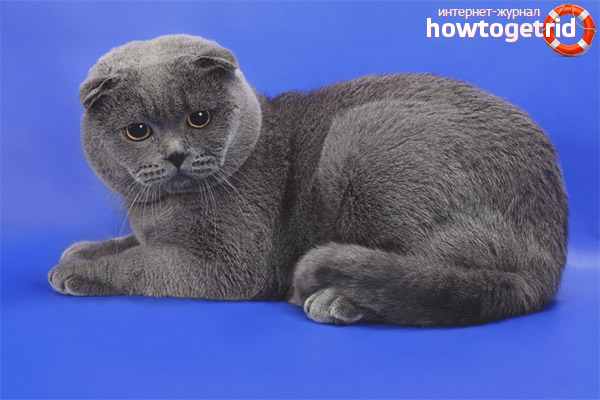
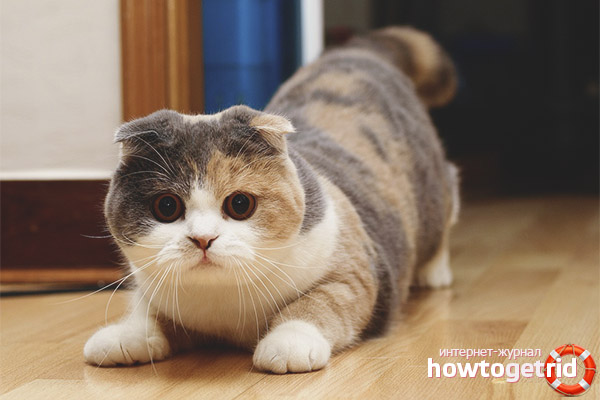
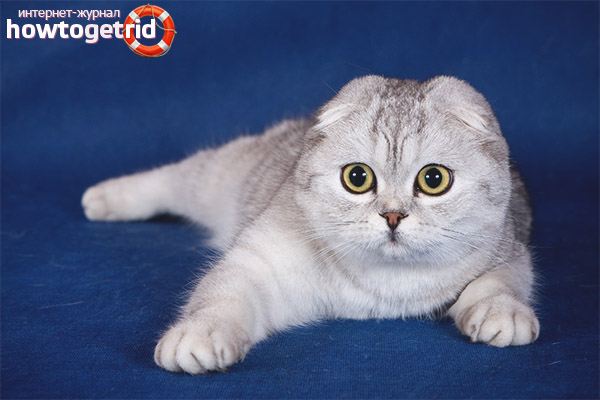
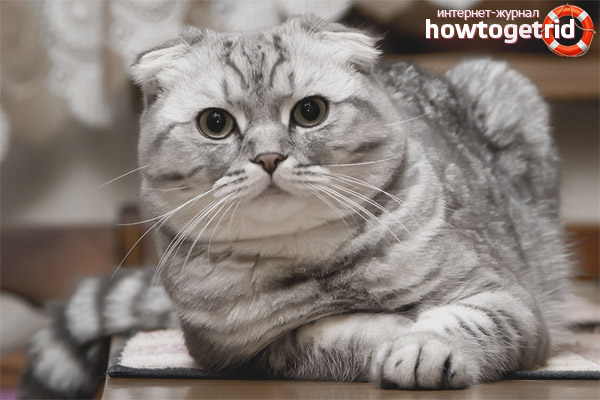
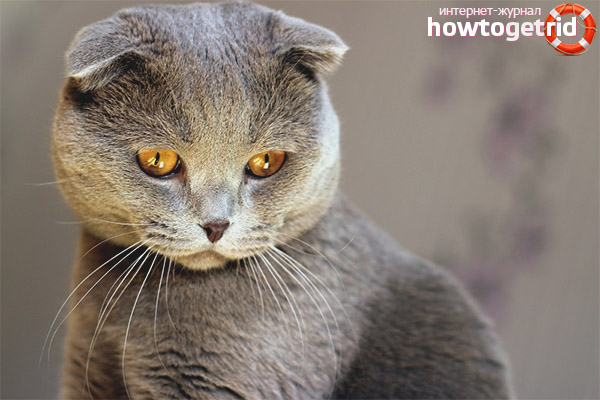








Submit